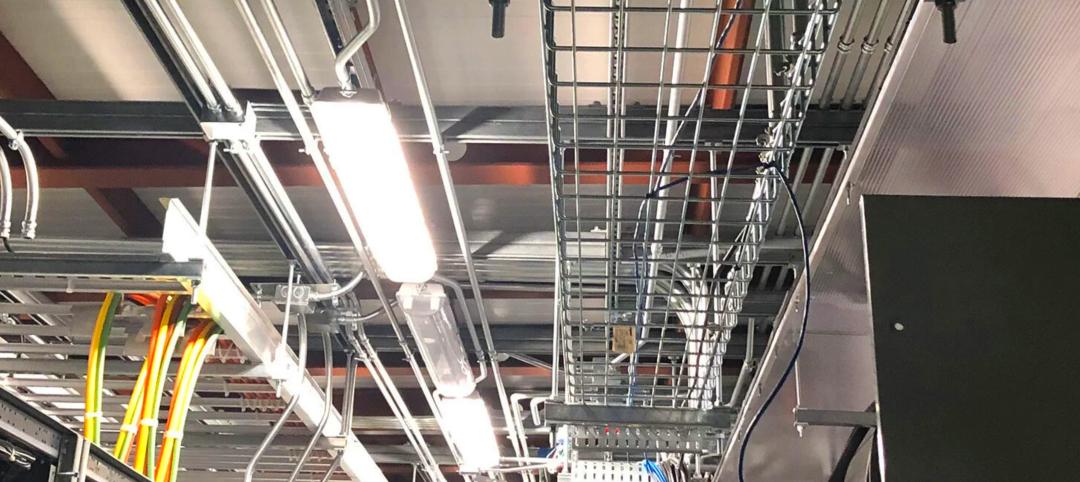Data center demand is expanding exponentially, with data creation expected to increase at a 23% compound annual growth rate through 2030. New operations to meet that demand, however, are imperiled by labor shortages and power infrastructure that isn’t keeping up with demand.
Those are some of the conclusions that Jones Lang Lasalle (JLL) draws in its U.S. Data Center Report for Midyear 2024. That report looks at conditions for the country and digs deeper into 18 markets. It compares leasing fundamentals such as construction and vacancy rates, rents, investment trends, and prospective demand from artificial intelligence.
JLL paints a picture of a data center market that has insatiable demand from users. At midyear 2024, the existing supply of colocation data center capacity in the U.S. stood at 12 GW. Colocation capacity in the U.S. has doubled since 2020, increasing at a 21% compound annual growth rate. Northern Virginia remains the largest market by a factor of four, accounting for nearly half of the capacity growth since 2020. But markets in the South and West regions have been faster growing on percentage basis.
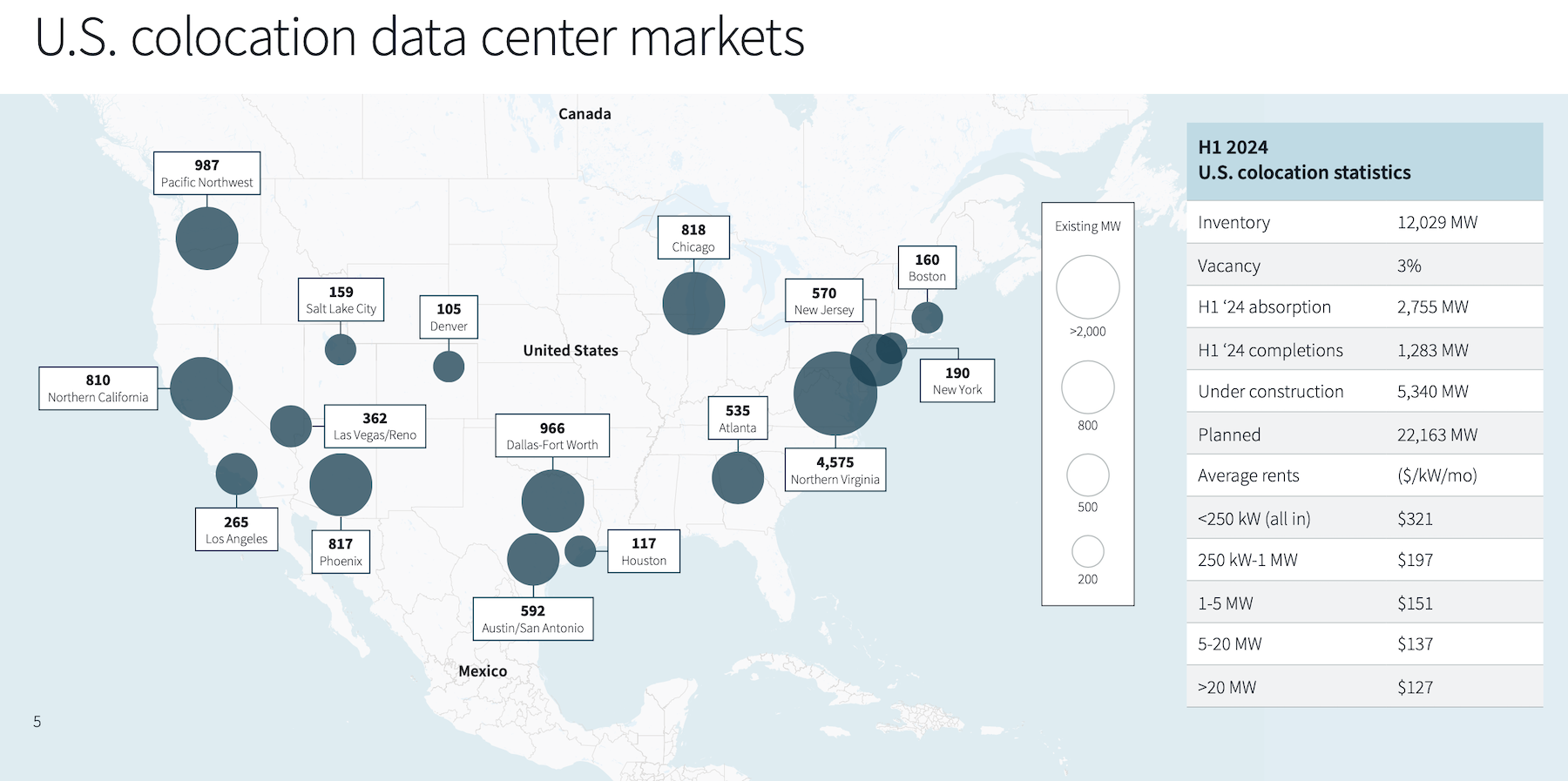
Currently, 76% of total colocation capacity resides in primary markets and 24% in secondary markets. Atlanta gained the top spot for colocation capacity under construction for the first time, following several years of heightened investor interest.
Nationally, construction and build-to-suit projects remain more active than core trades, as development yields on powered shell deals are pricing in the 7.5%-plus range and turnkey developments in the 9.5%-plus range. Projects reaching completion in 2024 were built to lower development yields than the market is bearing, and the stabilized cost of capital is contributing to a bid-ask spread.
Colocation completions increased to a new record of 1.3 GW in the first half of 2024. Nearly all the capacity delivering was preleased. The Northern Virginia market once again led the U.S. in completions, delivering 519 MW. The Pacific Northwest and Austin/San Antonio were standouts during JLL’s reporting period, delivering six and four times their traditional levels, respectfully.
With the completion of all projects currently under construction or planned, the U.S. colocation market will triple in size from current levels.
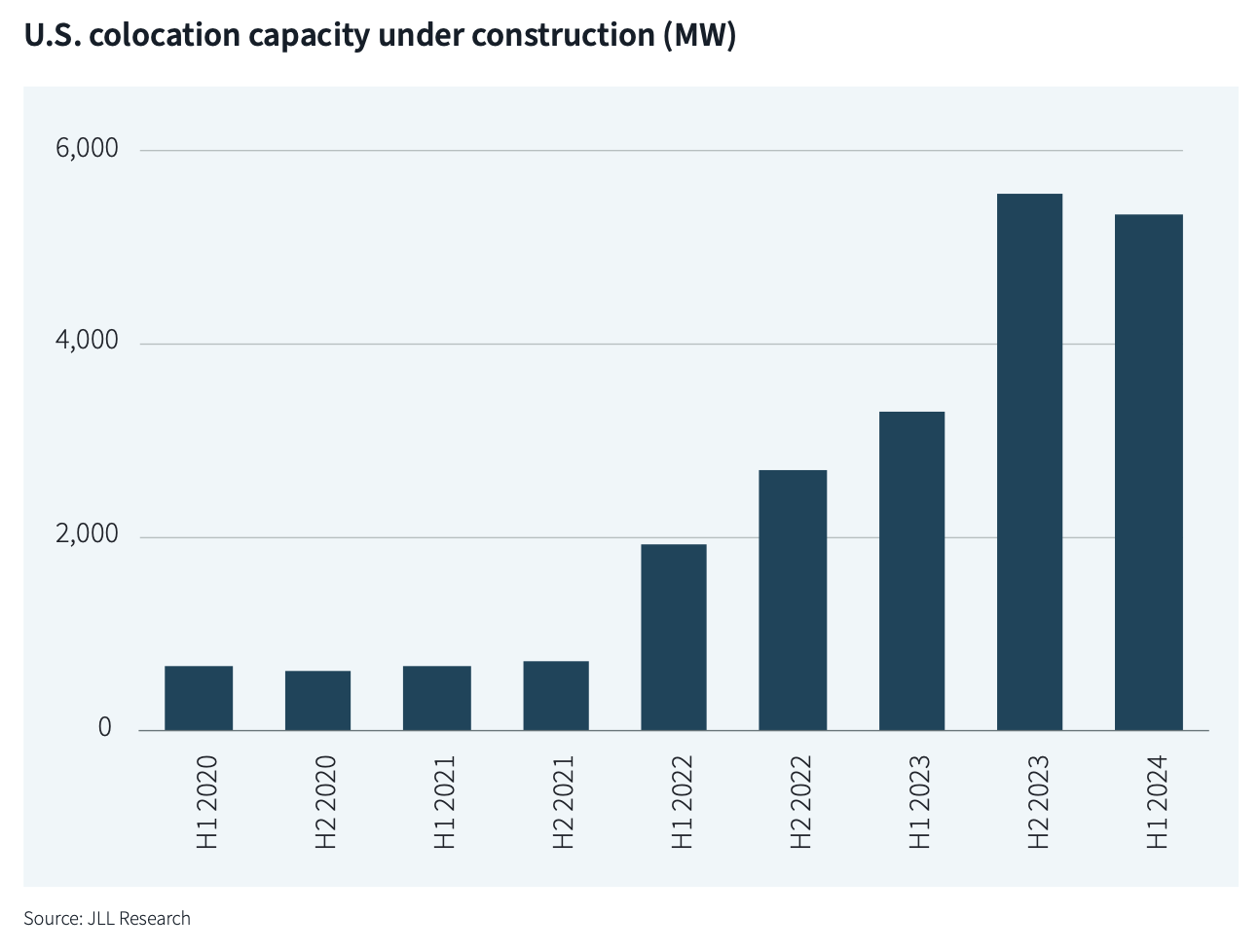
Still, colocation capacity under construction leveled off in the first half of 2024 at 5.34 GW (equal to the electrical consumption of the Tampa Bay region, and to over $53 billion in asset value). That drop-off could be a potential signal that the U.S. power grid cannot support faster development.
Despite rampant construction and completion activity, colocation vacancy declined to a record low of 3% at midyear 2024 due to insatiable demand. Simultaneously, colocation capacity under construction is 84% preleased. With limited existing vacancy, nearly all new data center demand is forced to lease capacity under construction. Given recent demand trends and the high preleasing rate for product under construction, vacancy will continue to trend towards 0% over the next few years, predicts JLL.
Skyrocketing data center rents
Absorption in the first half of 2024 reached a new record of nearly 2.8 GW, representing a ninefold increase over 2020 levels. Absorption was concentrated in four markets which had significant capacity breaking ground or delivering.
In aggregate, rents for the sector have increased at an 11% compound annual growth rate since 2020. However, rent increases have accelerated noticeably in the last year, states JLL. Commercial electricity rates were stable from 2010 through 2020 but have increased 25% in the last three years as power suppliers ramp up spending to address aging infrastructure and record demand. Meanwhile, the power grid is nearing full capacity.
Artificial Intelligence (AI) capital expenditures in recent years are estimated to be north of $300 billion, with investment levels accelerating in 2024. AI represents roughly 20% of new data center demand. What is known is that the largest global technology firms have announced significant AI CapEx targets for 2024, which will continue to fuel data center demand. An evolving storyline in recent months has been the shift in investor sentiment towards AI. Questions about the future revolve around investment trends, AI adoption rates, and the technology’s unclear path to profitability.
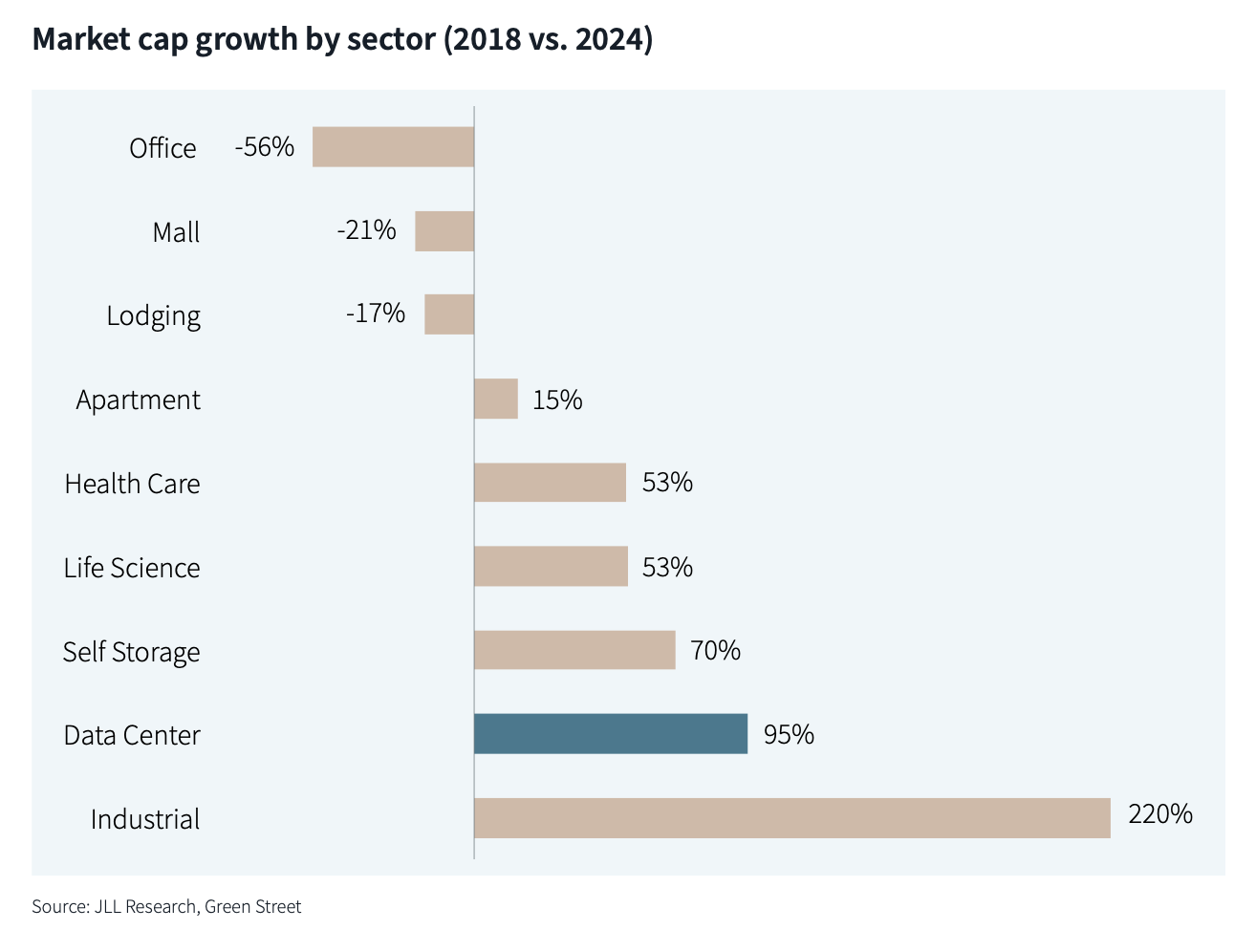
A power grid under more stress
The current power constraint situation the U.S. grid is facing is creating an opportunity for more capital inflows to the infrastructure and data center space. More capital is needed to support on-site energy campuses.
While data center power demand has been growing at a 21% CAGR in recent years, the sector only accounted for about 3% of total U.S. power in 2023. However, if trendlines hold, that percentage is projected surpass 11% within the next decade.
In aggregate, the U.S. power grid is not in danger of running out of capacity in the near term. But medium- to long-term challenges need to be addressed. During peak summer demand in 2024, the U.S. power grid was projected to operate at 94% of permitted capacity. By 2033, power demand could exceed supply when factoring in data center growth projections, planned power retirements and anticipated power additions. Solutions will present themselves, but investments in research and development need to be made today.
Developers are turning to bridge energy solutions such as fuel cells or supplemental natural gas turbines to activate projects on shorter schedules. More data centers are operating as a microgrid. And development is expanding into secondary and rural markets with more readily available power.
Technical labor at a premium
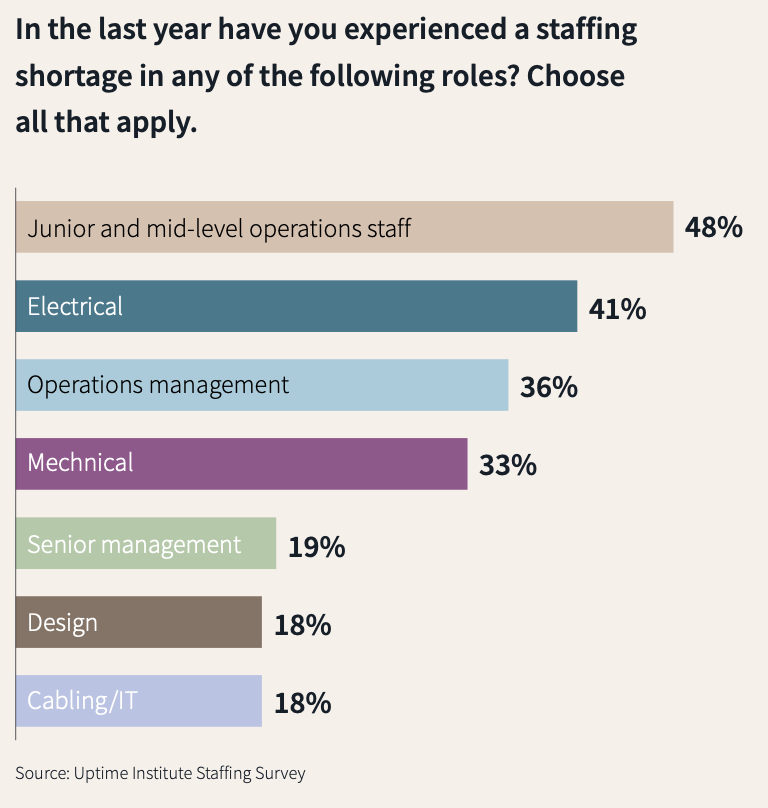
Finding the right talent remains a challenge for data center operators, and the issue is becoming more acute given the rapid expansion of the sector in recent years. Only about 15% of applicants meet the minimum job qualifications. It is estimated that 10% of data center roles at existing facilities are unfilled, more than twice the national average across all industries. As a result, data center operators have been resorting to cross-functional roles and staff augmentation.
Attrition is particularly severe among younger workers, where the retention rate in the first year of employment is only 18%. In exit interviews, data center employees list three primary reasons for resigning: pay, burnout, and career development. To address burnout in the industry, employers need to ensure a positive employee experience that extends beyond compensation.
Within the data center industry, one-third of the technical workforce is at or nearing retirement age. That ratio is likely to double in the next few years due to demographic trends. JLL states that, to withstand the current labor environment and forthcoming generational shifts, data center operators need to prioritize succession planning and establish clear career development pathways.
The operators might start with diversity: less than 10% of the data center workforce is female, and only 28% is made up of people of color. Educating these two cohorts about the employment opportunities within the data center industry would significantly expand the labor pool, suggests JLL.
Related Stories
Giants 400 | Feb 9, 2023
New Giants 400 download: Get the complete at-a-glance 2022 Giants 400 rankings in Excel
See how your architecture, engineering, or construction firm stacks up against the nation's AEC Giants. For more than 45 years, the editors of Building Design+Construction have surveyed the largest AEC firms in the U.S./Canada to create the annual Giants 400 report. This year, a record 519 firms participated in the Giants 400 report. The final report includes 137 rankings across 25 building sectors and specialty categories.
Data Centers | Feb 6, 2023
Modular electric rooms are the new normal
Southland Industries breaks down the prefabrication benefits of Modular Electric Rooms (MERs).
Sponsored | Resiliency | Dec 14, 2022
Flood protection: What building owners need to know to protect their properties
This course from Walter P Moore examines numerous flood protection approaches and building owner needs before delving into the flood protection process. Determining the flood resilience of a property can provide a good understanding of risk associated costs.
Data Centers | Nov 28, 2022
Data centers are a hot market—don't waste the heat!
SmithGroup's Brian Rener shares a few ways to integrate data centers in mixed-use sites, utilizing waste heat to optimize the energy demands of the buildings.
Giants 400 | Nov 9, 2022
Top 50 Data Center Contractors + CM Firms for 2022
Holder, Turner, DPR, and HITT Contracting head the ranking of the nation's largest data center contractors and construction management (CM) firms for 2022, as reported in Building Design+Construction's 2022 Giants 400 Report.
Giants 400 | Nov 9, 2022
Top 60 Data Center Engineering + EA Firms for 2022
Jacobs, Burns & McDonnell, WSP, and Alfa Tech top the ranking of the nation's largest data center engineering and engineering/architecture (EA) firms for 2022, as reported in Building Design+Construction's 2022 Giants 400 Report.
Giants 400 | Nov 9, 2022
Top 30 Data Center Architecture + AE Firms for 2022
HDR, Corgan, Sheehan Nagle Hartray Architects, and Gensler top the ranking of the nation's largest data center architecture and architecture/engineering (AE) firms for 2022, as reported in Building Design+Construction's 2022 Giants 400 Report.
Data Centers | Oct 31, 2022
Data center construction facing record-breaking inflation, delays
Data center construction projects face record-breaking inflation amid delays to materials deliveries and competition for skilled labor, according to research from global professional services company Turner & Townsend.
Data Centers | Oct 25, 2022
Virginia county moves to restrict the growth of new server farms
Loudoun County, Va., home to the largest data center cluster in the world known as Data Center Alley, recently took steps to prohibit the growth of new server farms in certain parts of the county.
BAS and Security | Oct 19, 2022
The biggest cybersecurity threats in commercial real estate, and how to mitigate them
Coleman Wolf, Senior Security Systems Consultant with global engineering firm ESD, outlines the top-three cybersecurity threats to commercial and institutional building owners and property managers, and offers advice on how to deter and defend against hackers.




